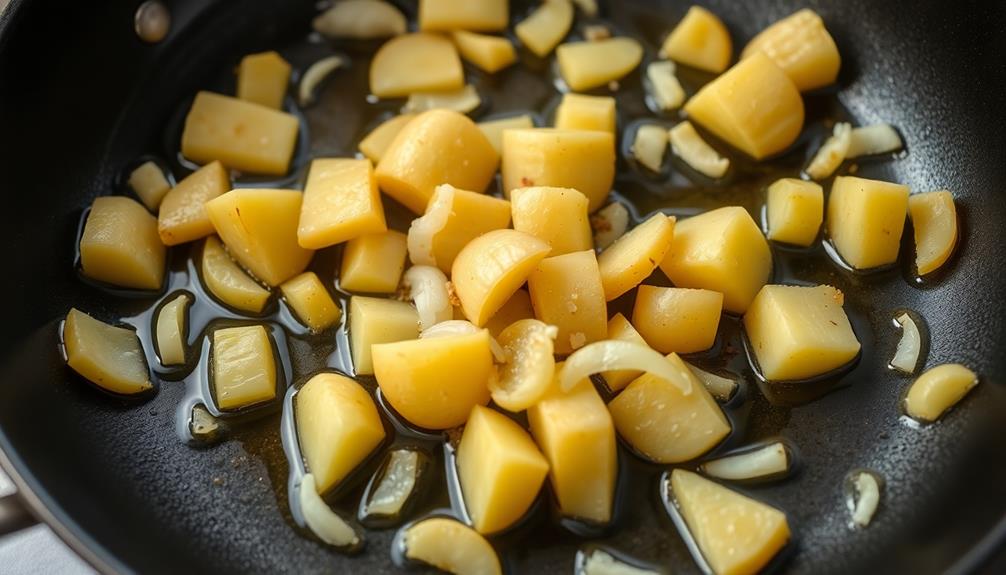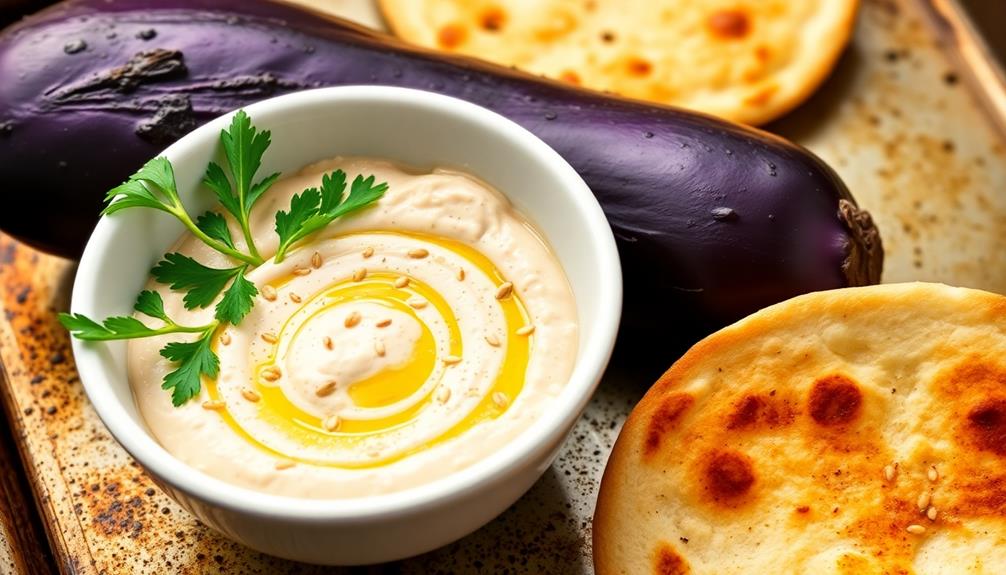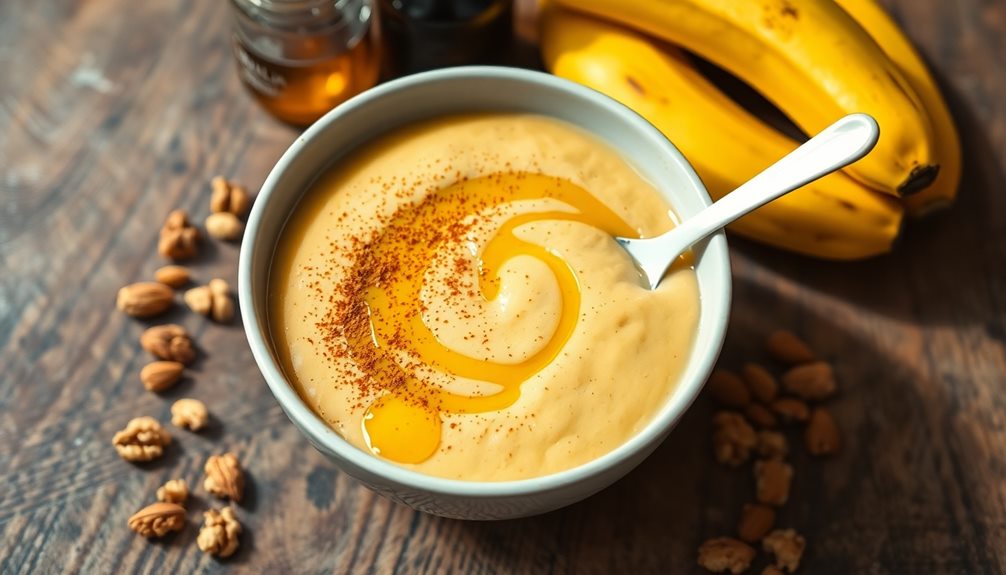You'll be immersed in Spain's rich culinary heritage when you try the tortilla española, an iconic omelette dish that originated in the 19th century. This classic combination of eggs, potatoes, and onions offers a delightful balance of crispy exterior and soft, custardy interior. It's a versatile meal, perfect as a tapas, main course, or satisfying snack. Customize it with extras like chorizo or cheese to suit your tastes. Mastering the technique of flipping the tortilla takes some practice, but it's worth it to enjoy this beloved Spanish comfort food. If you want to learn more about its history and regional variations, keep reading!
Key Takeaways
- Tortilla Española is a traditional Spanish omelette made with eggs, potatoes, and onions, representing a significant aspect of Spanish culinary heritage.
- The dish gained popularity during the Spanish Civil War as a staple food and is now frequently featured in tapas bars and enjoyed at home across Spain.
- The classic preparation method emphasizes fresh ingredients and technique, resulting in a crispy exterior with a soft, custardy interior.
- Tortilla Española is a versatile dish that can be served as a main course, tapas, or snack, and can be customized with additional ingredients like chorizo or cheese.
- The dish is considered a comfort food for its simplicity and satisfying nature, showcasing traditional Spanish cooking methods and local variations.
History
The tortilla española, a beloved Spanish culinary staple, has a rich and storied history that dates back centuries. This iconic dish, a thick, fluffy Spanish omelette made with eggs, potatoes, and onions, has become a beloved part of Spanish cuisine and culture. In fact, the tortilla española is often served as a tapa, or small snack, in bars and restaurants throughout Spain. It is also a popular dish to bring to picnics and gatherings. In addition to the tortilla española, Spain is also known for its variety of delicious Catalan soup dishes, such as the famous gazpacho and the hearty escudella i carn d’olla. These dishes showcase the rich and diverse culinary traditions found throughout the country.
The origins of the tortilla española can be traced to the 19th century, when it was a popular dish among the working classes. It gained widespread popularity during the Spanish Civil War, when it became a staple food for soldiers and civilians alike.
Today, the tortilla española is enjoyed throughout Spain, from casual tapas bars to fine dining establishments.
The preparation of the tortilla española is a time-honored tradition, with each family and region having its own unique variation. Whether served hot or cold, this versatile dish is a beloved part of Spanish culinary heritage.
Recipe
Tortilla Española, a classic Spanish dish, is a simple yet delightful combination of eggs, potatoes, and onions. This versatile dish can be enjoyed as a main course, a tapas item, or even a snack. Its rich, savory flavor and satisfying texture make it a beloved staple in Spanish cuisine.
The key to a perfect Tortilla Española is the combination of well-cooked potatoes and onions, coated in a flavorful egg mixture. The dish is then gently fried, creating a crispy exterior and a soft, custardy interior. It's a dish that can be easily customized to suit individual tastes, with the addition of ingredients like chorizo, spinach, or roasted peppers.
Ingredients:
- 6 large eggs
- 3 medium potatoes, peeled and thinly sliced
- 1 medium onion, thinly sliced
- 2 tablespoons olive oil
- Salt and pepper to taste
Instructions:
In a large non-stick skillet, heat the olive oil over medium heat. Add the sliced potatoes and onions, and cook, stirring occasionally, until the potatoes are tender and the onions are translucent, about 15-20 minutes. Drain any excess oil, if necessary.
In a separate bowl, beat the eggs and season with salt and pepper. Pour the egg mixture over the potatoes and onions, and gently lift the edges to allow the uncooked egg to flow underneath. Cook for 5-7 minutes, or until the bottom is set and the edges are golden brown.
To finish, slide the tortilla onto a plate, then carefully invert it back into the pan, cooking for an additional 5 minutes, or until the other side is golden brown. Slide the tortilla onto a serving plate and allow it to cool slightly before slicing and serving.
For best results, use a non-stick skillet and be gentle when flipping the tortilla to maintain its shape. The dish can be served warm or at room temperature, and pairs well with a simple salad or crusty bread.
Cooking Steps
Slice the potatoes into thin rounds and fry them in hot oil until golden brown.
Next, beat the eggs in a bowl.
Then, pour the beaten eggs over the fried potatoes and cook until the eggs are set.
Step 1. Slice Potatoes Into Thin Rounds

With a sharp knife, carefully slice the potatoes into thin, even rounds. The key is to slice them consistently, about 1/4 inch thick, to ensure they cook evenly in the pan.
Take your time and focus on making each slice uniform in thickness. If some are thinner or thicker, they may cook at different rates, which could affect the final texture of your tortilla.
After slicing, give the potato rounds a quick rinse under cold water to remove any excess starch. Pat them dry thoroughly with paper towels or a clean kitchen towel. This step will help the potatoes brown nicely when you fry them.
Be mindful of your fingers as you slice – keep them curled under and use the flat of the knife blade to guide your cuts.
Slow and steady is the way to go here. With a little practice, you'll be slicing potatoes like a pro in no time!
Step 2. Fry Potato Slices in Oil

Next, heat a large, nonstick skillet over medium-high heat and add enough olive oil to generously coat the bottom of the pan.
Once the oil is hot, carefully add the potato slices in a single layer, working in batches if needed. Fry the potatoes, flipping occasionally, until they're golden brown and tender, about 3-5 minutes per side.
Be sure to adjust the heat as needed to prevent the potatoes from burning. You want them to develop a nice, crispy exterior while remaining soft and creamy on the inside.
Once the first batch is done, transfer the fried potato slices to a paper towel-lined plate to drain off any excess oil.
Repeat with the remaining potato slices, adding more oil to the pan as needed.
The key is to fry the potatoes in small batches, allowing them to cook evenly and develop that irresistible golden-brown color and crispy texture.
Take your time and be patient – the results will be well worth it!
Step 3. Beat the Eggs

After frying the potatoes, crack the eggs into a large mixing bowl. You'll want to use about 6 large eggs for this dish.
With a fork or whisk, beat the eggs vigorously until they're well blended and frothy. Don't be afraid to really work those eggs – the more air you incorporate, the fluffier your tortilla will be.
Once the eggs are nicely beaten, it's time to season them. Add a pinch of salt and a dash of black pepper. You can also toss in a bit of chopped parsley or chives if you want to add some extra flavor.
Give the egg mixture another quick stir to combine the seasonings.
Now that your eggs are prepped, you're ready for the next step – adding the fried potatoes. Carefully fold the potato slices into the beaten eggs until they're evenly distributed.
Be gentle to avoid breaking up the potatoes too much.
Step 4. Pour Beaten Eggs Over Potatoes

Once the eggs and potatoes are ready, pour the beaten egg mixture over the fried potato slices. The eggs should cover the potatoes completely.
Gently tilt the pan to ensure the eggs flow evenly around the potatoes. Cook the tortilla over medium-low heat until the bottom is set, about 8-10 minutes. You'll know it's ready when the edges start to pull away from the pan.
Carefully slide a spatula under the tortilla to loosen it, then flip the whole thing over. Cook the other side for another 5-7 minutes until the center is set. The tortilla should be golden brown on both sides when done.
Slide the tortilla onto a plate and let it cool for a few minutes before slicing into wedges. Serve warm, at room temperature, or even chilled.
Enjoy this classic Spanish dish as a hearty breakfast, lunch, or tapas. The fluffy eggs and tender potatoes make for a delicious and satisfying meal.
Step 5. Cook Until Set

The eggs should cover the potatoes completely. Once the potatoes are evenly distributed in the pan, gently pour the beaten eggs over the top. You'll want to make sure the eggs reach the edges of the pan, ensuring the entire surface is coated.
Now, let the tortilla cook undisturbed over medium heat. As it cooks, the eggs will slowly set, forming a cohesive, frittata-like texture. Resist the urge to stir or flip the tortilla – you want the bottom to develop a golden-brown crust.
After 5-7 minutes, check the edges. If they're pulling away from the pan and the center is still slightly jiggly, it's time to flip. Carefully slide a spatula under the tortilla and invert it onto a plate.
Then, gently slide it back into the pan to cook the other side for another 3-5 minutes until fully set.
Final Thoughts
Why not take a moment to reflect on the key insights you've gained about the Tortilla Española?
You've learned that this classic Spanish dish is a versatile and delicious omelette made with eggs, potatoes, and onions. The key is to cook the potatoes and onions until tender, then add the beaten eggs and allow the tortilla to set. Flipping the tortilla can be tricky, but with a little practice, you'll get the hang of it.
One of the best things about the Tortilla Española is its adaptability. You can customize it with your favorite ingredients, like peppers, chorizo, or even leftover veggies.
And don't forget to serve it with a crisp salad or some crusty bread for a complete and satisfying meal. Whether you're hosting a tapas party or simply craving a comforting, home-cooked dish, the Tortilla Española is sure to become a new family favorite.
Frequently Asked Questions
What Is the Traditional Way to Serve a Spanish Omelette?
You traditionally serve a Spanish omelette at room temperature, sliced into wedges, and accompany it with some crusty bread, a simple salad, and a glass of chilled white wine or Spanish beer.
Can I Make a Vegetarian Version of the Spanish Omelette?
You can absolutely make a vegetarian version of a Spanish omelette. Simply swap out the traditional ingredients with your favorite veggies, and you'll have a delicious meatless dish that's just as satisfying as the original.
How Long Does a Spanish Omelette Typically Take to Prepare?
Preparing a Spanish omelette typically takes about 30-45 minutes. You'll need to sauté potatoes, eggs, and onions, and then cook the omelette to perfection. The hands-on time is relatively short, but it requires some patience to get the texture just right.
Are There Any Variations on the Classic Spanish Omelette Recipe?
Absolutely, there are plenty of variations on the classic Spanish omelette recipe. You can add ingredients like peppers, onions, or even chorizo to change up the flavor. Get creative and make it your own!
Can I Freeze the Leftover Spanish Omelette for Later Use?
Yes, you can freeze the leftover Spanish omelette. Once cooled, slice it into portions, wrap tightly in plastic or aluminum foil, and store in the freezer for up to 3 months. Reheat in the oven or microwave when ready to enjoy.










